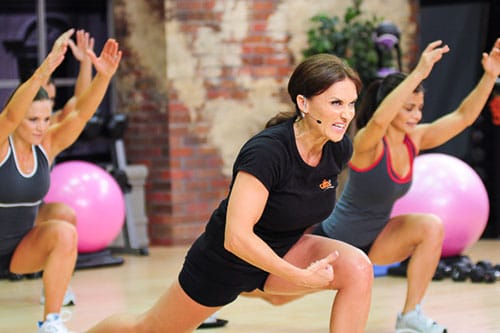In most of your workouts, you work both of your limbs at the same time. When you perform overhead barbell presses, you lift both arms at a time and when you do squats, you squat with both legs. How much time do you spend doing unilateral training?
Unilateral training is where you work a single arm or leg at a time, as opposed to working both simultaneously. Although it takes a little longer when you train one side at a time, adding unilateral moves to your workout has benefits. Here are some ways training one side at a time can improve your strength and fitness level.
Builds Core Stability
When you work one side of your body at a time, you activate your core muscles to maintain balance. This forces you to work stabilizing muscles that don’t always get the focus they deserve. Core stabilizers are your deep trunk muscles. They include the transversus abdominis, internal obliques, multifidus, and paraspinal muscles. These muscles stabilize and support your spine, protect against injury and back pain and improve your posture.
Increases Resistance to Injury
When you train unilaterally, the joint muscles that stabilize the working limb are called into play. When you consistently work these muscles through unilateral training, it strengthens them. This protects the limb against injury when you’re playing sports and when you’re lifting. Too often we focus energy on only working the muscles that produce the movement while ignoring the stabilizing muscles that support these muscles and maintain balance.
Strong stabilizing muscles not only prevent injuries – they help the working muscles the “movers” work more efficiently by providing support and stability. Stabilizing muscles are the “support team” that work behind the scenes to help the movers work better together. When your stabilizers aren’t strong it limits the amount of weight you can safely lift.
Strong stabilizers are important for reducing the risk of injury if you play sports and for carrying out functional activities you do every day. When you bend over to pick up a heavy object, you use your stabilizers for balance. When these muscles are strong, it reduces your risk of falling or injuring yourself. Unilateral work helps to strengthen the sometimes neglected stabilizers.
Correct Muscle Imbalances
Most people have one side that’s stronger than the other. If you’re right-handed, it’s usually your right side. When you have a non-dominant or weak side, it creates a muscle imbalance that increases your risk for injury. Unilateral training where you focus on the non-dominant side helps to “even things out” from a strength perspective, creating a more balanced, stable physique.
Good for Rehabbing an Injury
Not only does unilateral training help prevent injury – it helps you rehab after an existing one.
When you don’t work a limb as hard due to injury that limb becomes weaker. Focusing on the weaker side through unilateral training will help you restore strength to the injured limb for greater symmetry and balance.
Great Focus on the Muscle
When you train unilaterally you can really focus in on the side you’re working. This lets you maximize the range of motion during that exercise. Plus, you’re activating more muscle fibers due to the stabilizers you’re working.
Improving Balance
Ever tried a one-legged squat? It takes a good sense of balance. Doing one-legged moves regularly will help you develop the neural circuitry you need for better balance. Start by doing shallow one-legged squats without any weight. After you’ve developed confidence squatting with no weight, add a dumbbell. Gradually increase the weight over time. It takes persistence and practice to master the one-legged squat.
Unilateral Training Benefits BOTH Limbs
Here’s something that may surprise you. When you train the limb on one side it increases strength in the opposite limb as well. This is a phenomenon called muscle cross education. Of course, the limb you’re actively working benefits the most, but the opposing limb gets some strength training benefits even though it’s not being trained. Cross education causes about a 7.8% improvement in muscle strength in the untrained limb. This is true whether you work one arm or one leg. The opposite limb benefits too.
How can you explain this phenomenon? It’s not clear why cross education occurs. One theory training one limb modifies the neural circuits that control both limbs. How can you benefit from cross education? If you have an injured arm or leg that you have to rest, you can preserve some of the strength of that limb by training the uninjured limb.
Types of Unilateral Exercises
One-arm rows, unilateral dumbbell curls and triceps extensions, one-arm overhead presses, lunges, single-leg stiff leg deadlifts, one-arm lateral raises, and one-legged squats are all examples of effective unilateral exercises. Want to really challenge yourself? Try a one-handed push-up. Most people can’t do it but with practice and persistence, it’s not out of your reach.
The Bottom Line?
There are benefits to adding unilateral exercises to your workout, especially if you have muscle imbalances or play sports. Round out your routine by working one side at a time for some of your training and reap the benefits .
References:
Eur JAppl Physiol (2002) 86: 287-294.
Journal of Science and Medicine in Sport, 15(2), 94-101.
Sports Med. 2007;37(1):1-14
Related Articles By Cathe:
How Often Should You Change Your Strength Training Routine?
What Are Stabilization Exercises and Why Do You Need Them?
Related Cathe Friedrich Workout DVDs:
STS Strength 90 Day Workout Program
All of Cathe’s Strength & Toning Workout DVDs
Total Body Workouts
Lower Body Workouts
Upper Body Workouts


